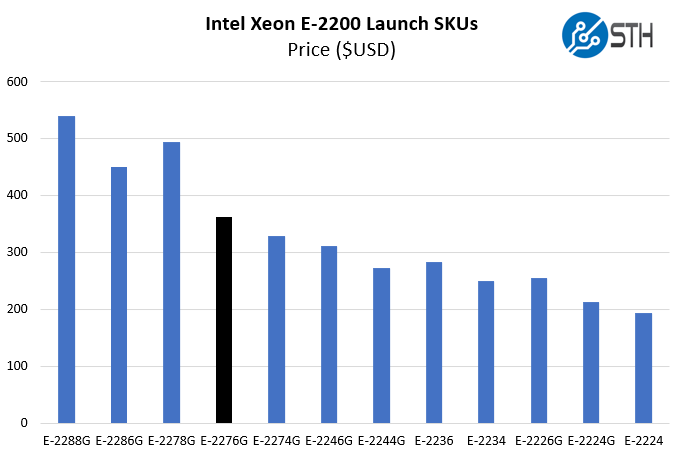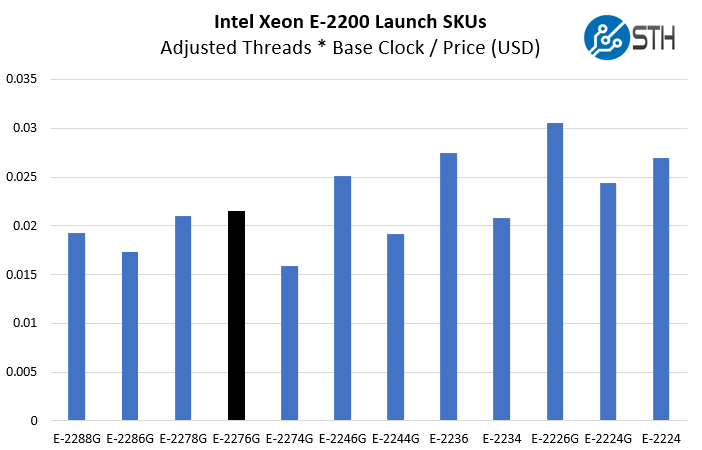Intel Xeon E-2276G Power Consumption
We wanted to post a few figures from our testing that show the real selling point of the chips, low power.
- Idle Power (Performance Mode): 37W
- STH 70% Load: 99W
- STH 100% Load: 137W
- Maximum Observed Power (Performance Mode): 143W
Note these results were taken using a 208V Schneider Electric / APC PDU at 17.7C and 72% RH. Our testing window shown here had a +/- 0.3C and +/- 2% RH variance. We double-checked on our 120V racks and were able to get power consumption over that common 1A threshold.
Intel Xeon E-2276G Market Positioning
The Intel Xeon E-2276G is not being released in a vacuum. Instead, there are other parts available in the socket which means that our readers need to decide on a chip in the context of a configurator. Here is what the parts look like ordered by part number:

Again, users can get confused why there is a Xeon E-2278G which is an increment of 2 higher than the Xeon E-2276G but costs much more. The Xeon E-2278G we have not tested but we expect to have much higher performance with 8 cores. Likewise, one may see similar pricing with the 4-core Xeon E-2274G, but we have shown one gets much more performance with the Xeon E-2276G.
Taking a look at how the Intel Xeon E-2276G stacks up against its stablemates when we take into account threads, clock speed, and price, this is what the above chart looks like:

As you can see, the Xeon E-2274G looks like a much lower value due to its similar price yet 33% fewer cores than the Xeon E-2276G. We also see the Xeon E-2276G pull ahead of the Xeon E-2278G in this metric due to the latter’s significantly higher price tag.
Versus the Intel Xeon E-2236, there is an important differentiator. A “G” in the model number here (except on the mobile side again) denotes an integrated GPU. If you need a basic GPU, for video transcoding or digital signage, the price of a GPU plus the CPU above will make the Xeon E-2276G a better buy.
On the performance side, the actual performance was extremely incremental. If you have a 6-core Intel Xeon E-2100 series SKU, you are not going to notice much of a performance bump from the new CPU. The big step function changes come with adding 2 more cores to 8 or subtracting 2 cores to 4.
Final Words
At the same price as the Xeon E-2176G, we see slightly more performance. If you are ordering new servers with the Xeon E-2x76G series there is no longer a reason to purchase the Xeon E-2176G. At the same time, one may look at the Xeon E-2246G at a $50 savings which can be 10% of a system cost in this segment and decide that is a reasonable trade-off.
If you are in the market for a Xeon E-2200 series platform, the Intel Xeon E-2276G is undoubtedly a solid part. It offers substantial cost savings over moving to the 8-core parts and even large cost savings over the Intel Xeon E-2286G. For most of our readers, the Xeon E-2276G is a better buy than the 86G part. We still cannot help looking at the results and wondering if Intel needs to do a SKU simplification initiative in this area. Looking at the results, are there that many buyers who need that fine of a price/ performance gradation? This finely optimized SKU stack made sense with lower clock speeds and a maximum of four cores, but with four, six, and eight-core alternatives, having three SKUs with six cores and the iGPU seems like overkill. That is a question for another day.




And some other ones:
Intel last night made public two more data leakage disclosures, which tie back to Zombieload and November’s TAA issue.
Here are the new disclosures:
CVEID: CVE-2020-0548
Description: Cleanup errors in some Intel(R) Processors may allow an authenticated user to potentially enable information disclosure via local access.
CVSS Base Score: 2.8 Low
CVE-2020-0549
Description: Cleanup errors in some data cache evictions for some Intel(R) Processors may allow an authenticated user to potentially enable information disclosure via local access.
CVSS Base Score: 6.5 Medium
CVE-2020-0548 is referred to as Vector Register Sampling and CVE-2020-0549 is going as L1D Eviction Sampling.
A speculative execution side channel variant known as L1D Eviction Sampling may allow the data value of some modified cache lines in the L1 data cache to be inferred under a specific set of complex conditions.
L1D Eviction Sampling is to be mitigated by new CPU microcode updates.
A speculative execution side channel variant known as Vector Register Sampling may allow the partial data values of some vector operations to be inferred under a specific set of complex conditions that include vector operations executing after a period of vector inactivity.
The award for the best use of Lego Minifigs in an IT component review goes to…. John Lee and STH!